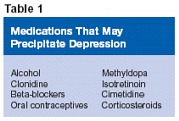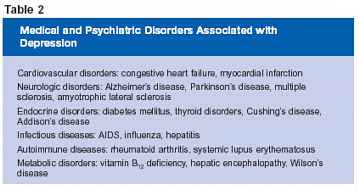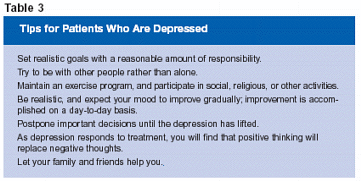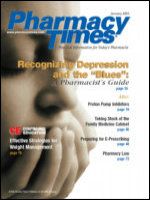Publication
Article
Pharmacy Times
Recognizing Depression and the "Blues": A Pharmacist's Guide
Author(s):
Most people from time to time feel sad or experience the ?blues,? perhaps during the grieving process following the loss of a loved one. Unlike clinical depression, which is a major mood disorder, the blues involve feelings of unhappiness in response to life experiences or stressors, including the loss of a job or a divorce. Yet, these feelings of sadness eventually diminish with time, once coping skills set in.(1)
Clinical depression, on the other hand, is a serious and very common illness, with a lifetime prevalence of 25% in women and 12% in men.(2)Unfortunately, only about one third of sufferers seek medical treatment. Although highly curable, depression is often inadequately treated and under-diagnosed because of the stigma that it is a sign of personal weakness and/or failure to ?get a grip.? This stigma may lead to a delay in treatment.
In addition to everyday stressors, certain medications and disease states (Tables 1 and 2) can precipitate depression in patients. Depression can interfere with normal everyday functioning and impact personal and work relationships. Without treatment, symptoms can last for weeks, months, or years.


Clinical Characteristics of Depression
Depression involves a cluster of symptoms such as the following:
? Difficulty in concentrating or organizing thoughts
? Feelings of persistent sadness, guilt, and worthlessness
? Loss of interest in sex or feelings of detachment from loved ones
? Fatigue or loss of energy nearly every day
? Thoughts of death or suicide
? Significant weight loss or gain
? Insomnia or hypersomnia nearly every day(2)
Types of Depression
Major depression is manifested by a cluster of symptoms that interfere with the ability to work, study, sleep, eat, and enjoy pleasurable activities. Disabling episodes of depression may occur only once but more commonly occur several times in a lifetime.
Dysthymia, a less severe form of depression, involves a long-term, depressed mood, with symptoms such as low energy and self-esteem, lack of concentration, appetite changes, and sleep disorders.(3)Such chronic symptoms do not disable but keep the patient from functioning well. Many people with dysthymia may experience a major depressive episode later in life.
Bipolar disorder, also called manic?depressive disorder, is characterized by mood swings involving episodes of mania alternating with depression.(1)Symptoms change according to the cycling mood changes. Patients experience symptoms of depression in the depressed cycle and increased talking, poor attention span, decreased sleep, and racing thoughts in the manic cycle. The heightened mood or euphoria experienced during the manic cycle can lead patients to become involved in unwise business decisions, shopping sprees, or illegal activities.(4)
Postpartum depression involves hormonal shifts and the overwhelming demands of motherhood. Whereas postpartum blues usually last a week to 10 days and do not interfere with everyday activities, postpartum depression is distinguished both by its duration and by its debilitating effects. Symptoms include crying for no apparent reason, restlessness, irritability, and anxiety. Postpartum depression often goes undiagnosed because of the reluctance of mothers to seek the help of their family or their physician.
Seasonal depression refers to variations in mood with a seasonal pattern. In fact, changes in the light/dark or sleep/awake cycles have been shown to trigger episodes of depression or mania.(5)Also referred to as seasonal affective disorder (SAD), seasonal depression is a common condition caused by decreased levels of daylight in the winter months. Episodes can lead to lack of energy and overall depressive symptoms. Treatment is difficult with traditional antidepres-sants, but light therapy appears to be effective, without serious side effects.(6)
Treatment Approaches to Depression
Although psychotherapy can help depressed patients, drug therapy is the mainstay of treatment. Antidepres-sant agents exert their therapeutic effect by increasing the availability of neurotransmitter activity in the synaptic cleft of neurons. The goal of treatment is to enable patients to return to a normal state of functioning, and approximately 65% to 70% of patients do improve with drug therapy.(7)Because all antidepressants are effective, selection of a drug is based on history of past response, potential for drug?drug interactions, tolerability, and cost. Monoamine oxidase inhibitors (MAOIs), such as phenelzine and tranylcypromine, were popular decades ago, but their use is limited due to their dietary restrictions and drug interactions. A hypertensive crisis can occur when MAOIs are taken with tyramine-containing foods such as aged cheeses, red wine, organ meat, and pickled herring. Medication restrictions for patients taking MAOIs include appetite suppressants, dex-tromethorphan, and ephedrine.
Tricyclic antidepressants (TCAs) are effective in treating depressive disorder. TCAs increase the activity of both norepinephrine and serotonin by blocking their reuptake. Doses are initially low, with gradual titrations, because these agents cause many side effects, such as dry mouth, constipation, urinary retention, tachycardia, and dizziness. TCAs consist of either tertiary amines (amitriptyline, imi-pramine, and doxepin) and secondary amines (desipramine, nortriptyline), with the latter exhibiting fewer anti-cholinergic effects.
Selective serotonin reuptake inhibitors (SSRIs) are the drugs of choice and are widely prescribed today. They produce fewer anticholinergic effects than TCAs and are better tolerated, so that compliance is improved. Unlike TCAs, they are not lethal in overdose. The main adverse effects of SSRIs are diarrhea, headache, nervousness, and sexual dysfunction. Agents in this class include citalopram, fluoxetine, paroxe-tine, sertraline, and fluvoxamine.
Bupropion is a mixed norepineph-rine?dopamine reuptake inhibitor with similar efficacy to that of TCAs and SSRIs. Side effects include insomnia, agitation, confusion, and weight loss, but minimal sexual dysfunction occurs. Bupropion is contraindicated in patients with seizure disorder, and the incidence of seizures appears to be dose related.
Venlafaxine enhances both norepi-nephrine and serotonin, with some effect on dopamine. Its side-effect profile is similar to that of SSRIs; however, venlafaxine has been associated with a slight increase in blood pressure. Nefazadone, a serotonin reup-take inhibitor similar to trazodone, works on serotonin as well, with less sexual dysfunction than that associated with SSRIs. A recent black box warning has linked nefazodone to hepatic failure, however. Mirtazapine increases both norepinephrine and serotonin and is associated with weight gain and sedation.
Patient Counseling Tips
Pharmacists can indeed play a critical role in counseling patients and making them understand their illness and the importance of adhering to a therapeutic program. Because pharmacists are the most accessible health care professionals, they are well suited to educate patients about depressive disorder and to attempt to reduce the stigma associated with it. Here are some questions patients may ask and possible points for pharmacists to cover during a counseling session:
? How long will it take the medication to work? Stress that optimal results will take 3 to 4 weeks.
? How long can I expect to take the medication? Advise patients that therapy should continue even after mood elevation to prevent a relapse (usually 6 months or more after recovery from the first episode).
? Can I drink alcoholic beverages while on the medication? Because alcohol has a depressant effect on the nervous system, it can interfere with the efficacy of the drug.
? What side effects will I experience?
This is a good opportunity to review the side-effect profile of the particular drug and to emphasize that many side effects will subside with time.
The pharmacist should inquire as to the condition for which the medication was prescribed, because antide-pressants also are prescribed for other mood disorders.
Depression causes emotional pain and disrupts the lives of millions of people. It can bring about negative thoughts and feelings. A prompt diagnosis by the family physician can lead to adequate treatment and help in dealing with negative thoughts and feelings (Table 3). Pharmacists can contribute to the care of patients by using counseling opportunities to help patients recognize, prevent, and resolve issues leading to poor compliance.

For a list of references, send a stamped, self-addressed envelope to: References Department, Attn. D. Campagnola, Pharmacy Times, 241 Forsgate Drive, Jamesburg, NJ 08831; or send an e-mail request to:
.







